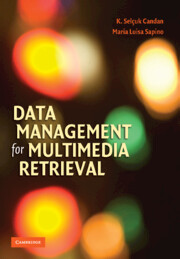Book contents
- Frontmatter
- Contents
- Preface
- 1 Introduction: Multimedia Applications and Data Management Requirements
- 2 Models for Multimedia Data
- 3 Common Representations of Multimedia Features
- 4 Feature Quality and Independence: Why and How?
- 5 Indexing, Search, and Retrieval of Sequences
- 6 Indexing, Search, and Retrieval of Graphs and Trees
- 7 Indexing, Search, and Retrieval of Vectors
- 8 Clustering Techniques
- 9 Classification
- 10 Ranked Retrieval
- 11 Evaluation of Retrieval
- 12 User Relevance Feedback and Collaborative Filtering
- Bibliography
- Index
- Plate section
11 - Evaluation of Retrieval
Published online by Cambridge University Press: 05 July 2014
- Frontmatter
- Contents
- Preface
- 1 Introduction: Multimedia Applications and Data Management Requirements
- 2 Models for Multimedia Data
- 3 Common Representations of Multimedia Features
- 4 Feature Quality and Independence: Why and How?
- 5 Indexing, Search, and Retrieval of Sequences
- 6 Indexing, Search, and Retrieval of Graphs and Trees
- 7 Indexing, Search, and Retrieval of Vectors
- 8 Clustering Techniques
- 9 Classification
- 10 Ranked Retrieval
- 11 Evaluation of Retrieval
- 12 User Relevance Feedback and Collaborative Filtering
- Bibliography
- Index
- Plate section
Summary
In the previous chapters, we have covered various feature extraction, indexing, clustering, and classification techniques, all of which transform the raw data collected through various capture devices into models and data structures that support efficient and effective matching and retrieval. Many of these techniques are, however, lossy in nature:
▪ Feature extraction algorithms need to map a potentially infinite, continuous feature space into a finite feature model that can be represented using a finite data structure.
▪ Feature selection (to avoid the dimensionality curse) for indexing and query processing usually involves some transformation of the data to highlight important features and to eliminate others that are not as important from consideration.
▪ Indexing, clustering, and classification algorithms often trade efficiency against effectiveness. Therefore, they can introduce both false hits and misses.
As we briefly discussed in Section 4.2.1, all forms of information loss may not have the same impact on the retrieval effectiveness. For example, false hits (which can be eliminated through postprocessing) are often acceptable, whereas misses (which cannot be eliminated) are not. On the other hand, in many other applications (especially in those cases where user queries are not precise and, thus, there are large numbers of matches), completeness of the result set is less important than the precise ranking of the few initial results: a ranking that can help the user pick a promising result from the first few is better than a ranking that is complete but puts the most promising results in the bottom of a long list.
- Type
- Chapter
- Information
- Data Management for Multimedia Retrieval , pp. 380 - 397Publisher: Cambridge University PressPrint publication year: 2010

